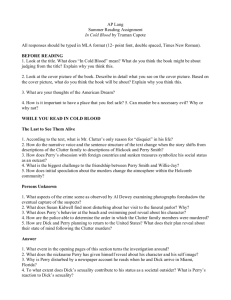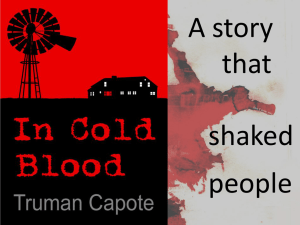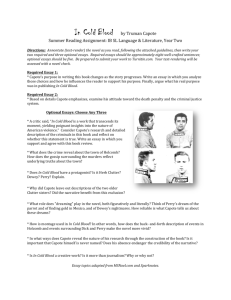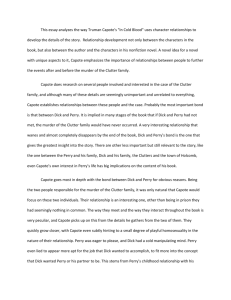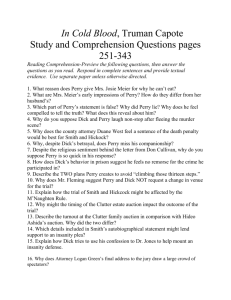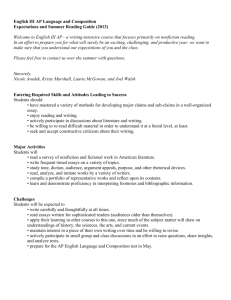In Cold Blood
advertisement
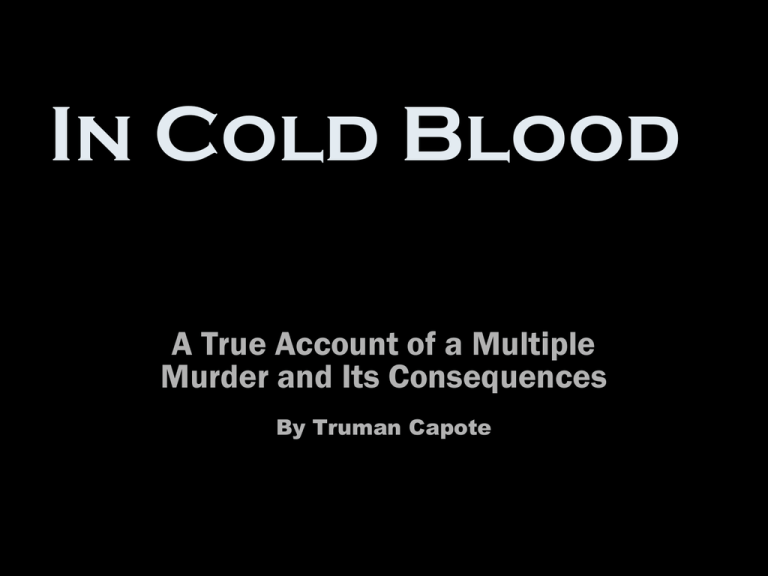
In Cold Blood A True Account of a Multiple Murder and Its Consequences By Truman Capote Garden City Family Slain Over Weekend In Cold Blood •A work of creative non-fiction •Written like a novel, but depicting actual events •Not necessarily chronological •Told from alternating points of view •The family •The criminals •The investigators •The townspeople Truman Capote • Born 1925 • Childhood friend of Nell Harper Lee • Read of Clutter murders in New York Times • Began researching at age 35 • Novel first serialized in The New Yorker in 1965 • Novel launched his career to the high society circles • Died 1984 Setting The Road to the Clutter home The village of Holcomb stands on the high wheat plains of western Kansas, a lonesome area that other Kansans call “out there.” Law… •The Victims •The Criminals •The Witnesses The Victims Herb Clutter •Head of the Clutter household •Well-liked, respected member of the Holcomb community •Fairly prosperous •Murdered, November 15, 1959 Bonnie Clutter • • • • Wife of Herb Clutter Mother of four A recluse Murdered, November 15, 1959 Nancy Clutter • • • • • Daughter of Herb and Bonnie Clutter Well-liked and popular Bright, energetic, responsible Dating Bobby Rupp Murdered November 15, 1959 Kenyon Clutter • • • • • Son of Herb and Bonnie Clutter Quiet and reserved Enjoys working with his hands Fifteen years old Murdered November 15, 1959 The Criminals Perry Smith •Convicted thief •Sentenced to Kansas State Penitentiary •Met Dick Hickock in jail Dick Hickock •Inmate in Kansas State Penitentiary •Friend of Perry Smith •Learned of Clutter family from fellow inmate Floyd Wells The Investigators KBI Alvin Dewey Main detective in the Clutter investigation Acquaintance of Herb Clutter Other Investigators (left to right) KBI Supervisor Al Dewey, County Attorney Duane West, Sheriff Earl Robinson, and KBI Agent Clarence Duntz THEMES: Limitations of The American Dream In Cold Blood presents a conflicted image of the notion of the American Dream. The text portrays a prosperous, homogenous, middle-class community, Holcomb, Kansas, that is forced to question its values and its sense of safety and security when the Clutter family is murdered. THEMES: Limitations of The American Dream Capote’s text was among a growing number of novels and plays written in the early part of the twentieth century that questioned the validity of the promises made by the American Dream. Texts such as Arthur Miller’s Death of a Salesman, John Steinbeck’s The Grapes of Wrath, and F. Scott Fitzgerald’s The Great Gatsby, among many others, simultaneously celebrate and criticize the concept of an American Dream. THEMES: Limitations of The American Dream These texts warn Americans not to take the Dream for granted and encourage readers to recognize that the American Dream is available only to a small group of individuals while excluding a vast majority of people from its promises. Theme: The American Dream In Cold Blood not only focuses on the Clutter family’s loss of the American Dream, it also portrays the failure of the American Dream for the criminals. For Richard Hickock and Perry Smith, a modern, comfortable middle-class lifestyle is unattainable. Raised in a dysfunctional family, Perry Smith considers himself to be misunderstood and, like Richard Hickock, falls into a life of petty crime. Unable to create a stable existence, the two ex-cons accept their roles as society outsiders and survive by stealing and writing false checks. Theme: The American Dream But the American Dream not only fails Dick Hickock and Perry Smith because they come from lower-class families and drift into a life of crime. The two men, particularly Perry Smith, are also haunted by psychological challenges. Richard Hickock chases women, but is secretly struggling with his sexual attraction to children. Perry Smith is physically handicapped as a result of a car accident. He is depressed and feels misunderstood. Continued… He suffers from feelings of shame due to his physical deformity. Considering himself to be a creative and artistic genius, Perry cannot fit into a world that does not share or recognize his vision. Perry’s wish of becoming an artist remains confined to his daydreams: “Singing, and the thought of doing so in front of an audience, was another mesmeric way of whittling hours. He always used the same mental scenery—a night club in Las Vegas, which happened to be his home town. It was an elegant room filled with celebrities excitedly focused on the sensational new star.” Continued… Both criminals eventually undergo psychiatric evaluations as they await their trial, and although the court system finds both of them to be mentally stable, Capote leaves his readers with the suggestion that the system at large has failed these two young men, ignored their psychiatric needs, and ultimately turned them into social outcasts and criminals. Major Themes: Loss of Innocence The Clutter killings are a turning point for the citizens of Holcomb and Garden City: for the first time, the dangerous wider world seems to threaten their peaceful existence, and their former naïveté gives way to feelings of doubt, fear and suspicion. According to Capote, it is the first time the citizens of this part of Kansas have had to endure the “unique experience of distrusting each other” Continued… Their version of the American dream – of safety, security, and the ability to determine their own fate – becomes undermined, if not entirely thwarted, by the victimization of the Clutters. Their view of the world must suddenly include another kind of person, a poor, embittered, “rootless” person, for whom this dream was never an option in the first place. Major Themes: The Banality of Evil When the murders are first discovered, Perry and Dick, as “persons unknown,” are elevated to an inhuman, almost mythic stature, the essence of a pure and motiveless evil that has come to destroy the peaceful lifestyle of the Holcomb residents. Capote, however, replaces this simplistic view with a more nuanced and sensitive interpretation, by exploring the material, psychological, environmental circumstances that cause two otherwise ordinary human beings to commit such an atrocious act. Continued… Throughout the novel, Perry and Dick are transformed from heartless, cold-blooded menaces, whose actions seem to defy human logic, into the fraught, pitiful, completely humanized individuals they are at the end of the book, and the crime itself is boiled down to a very basic and fairly understandable set of emotional responses. Although he does not attempt to excuse their actions, Capote shows how ordinary feelings of frustration and despair accidentally erupt into such an extraordinary crime. The book seems to contend that criminality and “evil” are not things apart, as we tend to define them, but normal human responses that merely become amplified and find a destructive outlet. Major Themes: Family Family life is a key determinant of individual character in the context of the book. The Clutters, who symbolize the utmost integrity of family life, are obliterated by Perry, who represents everything it means to come from a broken home. Continued The Clutters’ uprightness is related to the strength of their family, as Perry’s criminality is connected to the dissolution of his own kinship ties. In spirit, Dick is still wedded to his first wife, and his dreams of becoming selfsufficient are linked to the ability to support her and their three sons. The strength of a person’s family ties has the larger implication of whether that person can live happily, welloff, and in a self-determined fashion. Major Themes: Self Image The theme of self- or ego-image is crucial to understanding the interpersonal dynamics of Perry and Dick, especially those that lead to the eventual murder spree. Both men, Perry especially, are highly image-conscious and attuned to how others perceive them. Towards the end of the book, we learn from Perry’s psychiatric evaluation that he is “overly sensitive to criticisms that others make of him, and cannot tolerate being made fun of. He is quick to sense slight or insult in things others say”. Continued… • In some sense, the rivalry between Dick and Perry is a mutual struggle for self-recognition, with each wishing the other man would validate his own selfimage (this may be fueled, as some critics have suggested, by homoerotic desire). Self-image represents, in a larger sense, social status and self-determination, neither of which is available to these men. For Perry, the botched robbery at the Clutters is a painful reminder of his own lack of means or social mobility, and his feelings of shame and self-loathing at this realization are ultimately at the root of his homicidal rampage. Major Themes: Homosexuality Homoerotic desire is just below the surface of the relationship between Dick and Perry, between Perry and Willie-Jay, and, more implicitly, in the meta-textual relationship of Truman Capote to his two subjects. Whether or not these attractions were overtly acknowledged or even consciously realized by their subjects (Capote thought it was likely that both men had repressed these feelings), they are a palpable subtext of the narrative and serve several functions. Continued… On one level, they elucidate the relationship of Dick and Perry, adding a layer of intensity to their interactions that helps to explain why, for example, they might have become so frustrated at the Clutter home, or why so much of Perry’s self-image rests on Dick’s opinion of him. But the theme of homosexuality also functions as a larger symbol of, and premise for, Dick and Perry’s status as outsiders, social misfits for whom conventional society seems to have no place. Continued… At the time that In Cold Blood was penned, homosexuals were considered a threat to the social order, so much so that the F.B.I. kept official watch lists in order to monitor their activities. This unspoken element of their relationship heightens the intensity of their clash with conservative, small-town American life, and raises the stakes of the murder trial by a perceptible margin. Major Themes: Mental Illness Perry and Dick’s criminal tendencies are revealed to have underlying medical causes (Perry suffers from paranoid schizophrenia, and Dick has brain damage from a concussion); the difficulty of the murder trial becomes, to what extent are they still accountable for their actions? Continued… In a larger sense, the book seems to grapple with the question of whether the same moral standards are applicable to all people, regardless of their upbringing and their life circumstances; or whether Perry and Dick are in some measure redeemed (at least morally, if not legally) by the fact of their mental illness, and the fact that their own lives have been so lacking. The Non-Fiction Novel • With the publication of In Cold Blood, Truman Capote debuted a new literary genre: the non- fiction novel. The non-fiction novel presents real events through the use of literary techniques generally associated with fiction narratives. In the case of In Cold Blood, Capote used news- paper accounts, investigative reports, letters, and interviews to piece together the story of the Clutter murders and the subsequent hunt for and eventual execution of Richard Hickock and Perry Smith. Capote traveled to the Holcomb area just months after the murders, and he spent six years collecting information, interviewing residents, and observing the work of the Kansas Bureau of Investigations under the leadership of Al Dewey. Yet, like a novel, the story is presented in vivid sentences and filled with evocative descriptions, poignant word choice, and lyrical images. Continued… As a non-fiction novel, the text does not present the voice of the author or a specific narrator but, instead, relates the events and presents details from the points of view of different characters. The genre is closely associated with the journalistic novel and is generally considered to be a forerunner of the True Crime genre. True Crime has since evolved into one of the most popular literary genres, often exploiting highly sensationalized crimes. True Crime most frequently presents real, often well-publicized, murder cases and focuses on investigative strategies and criminal psychology, including psychological profiling of perpetrators and victims. Narrative Point-of-View Within each section of the text, the narrative viewpoint shifts between presenting events and details from the perspective of the Clutter family, the citizens of Holcomb, and the Kansas Bureau of Investigations investigators to the perspectives of Richard Hickock and Perry Smith. Capote himself never interjects the narrative with his authorial voice. Instead, he relies on the voice of his characters, including letters, interviews, newspaper accounts, etc., to present the events. Continued Whenever Capote presents the perspective of the Clutters and their neighbors, his sentences are welldeveloped, complex, with vivid, descriptive diction. Whenever the perspective shifts toward the points of view of Perry Smith and Richard Hickock, the sentence structure tends to be shorter and frequently interfused with fragments. Additionally, sections presenting Perry and Dick’s world often utilize colloquialisms and slang. The shift in narrative tone helps reinforce the social discrepancy between the comfortable middle-class world of the Clutters and the lower-class, poverty-stricken world of Dick and Perry. Keep in mind… • The lessons on Human Evil we have presented in class… • Your final essay/project will be to diagnose the murderers under one classification of Human Evil
